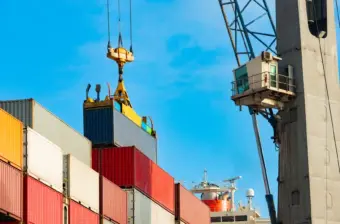If anything is clear in this turbulent election season, it is presidential candidate Donald Trump’s intention to levy high tariffs on all U.S. imports. Experience shows and economists agree that tariffs lead to persistently higher prices for customers. But the near-term damage will be even greater if massive disruptions in supply chains create chaos for businesses that rely on imports.
Trump has promised to increase tariffs on imports from China by 60 percentage points and on all other imports by 10 to 20 percentage points. His insistence that this would not make American consumers and businesses pay higher prices reflects a basic misunderstanding of how tariffs work in practice.
When an importer brings a good into the United States, it pays a tariff to the U.S. government equal to a percentage (for example, 10 or 20 percent) of the price paid to the foreign exporter. Importers have essentially three choices in this situation: (1) pass the tariff along to their customer, (2) eat the tariff and suffer lower profits, or (3) renegotiate contracts with suppliers or find and then switch to suppliers with lower prices (a costly process).
Some foreign exporters will doubtless lower their prices to stay competitive in U.S. markets, in which case foreigners would indeed bear part of the burden of the tariff (while the U.S. Treasury would collect less revenue from importers). However, studies of the duties levied during the last Trump administration show that price reductions by exporters were minimal at best.
Instead, the 2018–19 tariffs nearly always meant that, including the tariffs, U.S customers paid higher prices for the affected imported goods—in fact, prices that were higher by the full amount of the tariff.
The 2018–19 tariffs had other negative effects. The U.S. tariffs reduced exports of U.S. manufacturers that relied on imported intermediate goods because those U.S. companies couldn’t completely reconfigure their supply chains to offset higher costs. Trump’s tariffs also brought on retaliatory tariffs by other countries, which caused some U.S. exporters to substantially lower the prices they charged abroad to maintain foreign market share. The Federal Reserve’s Beige Book, which compiles concerns raised by the U.S. business community, mentioned tariffs 30 times in its 25-page November 2019 edition. Many respondents cited tariff and trade uncertainties as worries, while others complained about supply-chain disruptions, tariff-related cost increases, stock-building as a hedge against trade uncertainty, or pressure from clients to absorb the costs of tariff hikes through lower profit margins. A study of quarterly earnings calls of publicly traded companies in 2018 found that supply chain disruptions and raw material costs were the two most frequently mentioned concerns. In addition, global manufacturing contracted in the wake of Trump’s tariffs.
A less visible cost of the tariffs came from the frenzy of appeals for exemption. A bewildering array of politically favored importers won tariff relief from the Trump administration. This process imposed heavy costs on small- and medium-sized enterprises that were ill-equipped to jump through the bureaucratic and political hoops.
In thinking about how costly Trump’s proposed tariffs on all goods imports would be, consider this: He now wants to levy tariffs on more than 10 times the amount of imports as in his first trade war. The earlier Trump tariffs covered around $380 billion of U.S. imports, while goods imports totaled $3.1 trillion in 2023. Aside from inflation and other adverse macroeconomic effects, including the effects of retaliation from our trade partners, chaos would erupt in global supply chains as U.S. importers struggled to avoid the impacts of tariffs.
The repercussions of these tariffs would be felt by every firm that sells imported goods and by every firm that uses imported inputs to run its business. Prices will rise, production will be depressed, and employment will likely fall, particularly in sectors exposed to higher input prices or foreign retaliation.
What should worry us just as much, however, is the prospect of near-term chaos. Every importer and every purchaser of imported intermediate goods would shift attention from day-to-day business needs in their scramble to renegotiate contracts, reconfigure supply chains, and lobby for tariff exemptions—all in an uncertain, highly politicized trade environment. Thanks to the pandemic, we know what our economy looks like when supply chains are massively disrupted: Product costs spike, and shelves are empty. Why on earth would we want to repeat that mess?



